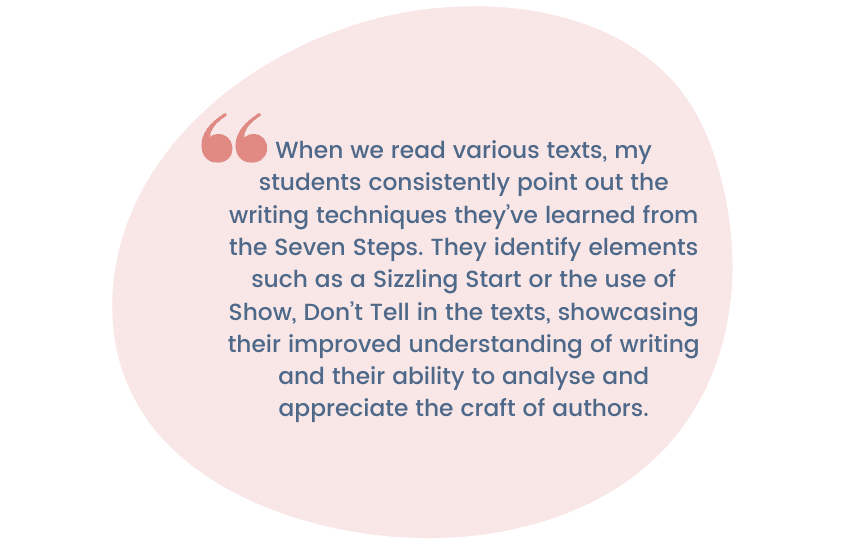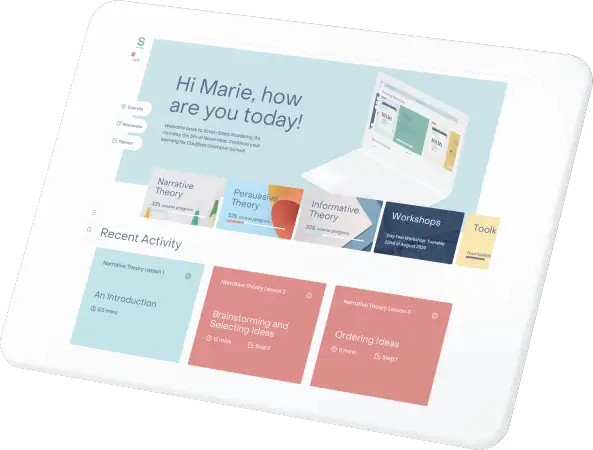Hands up if you struggle to create explicit links between your reading and writing programs 🙋♀️
A lot of teachers do. Which makes sense, given that educators are well supported in teaching and assessing reading but largely left to wing it when it comes to teaching and assessing writing. (A yawning gap that Seven Steps is here to fill!)
But research shows that there are great benefits for students when reading and writing instruction is integrated across the curriculum. In fact, the Australian Curriculum, the Victorian Curriculum and the NSW Syllabus have this at their heart.
So, how can you ensure the symbiotic relationship between reading and writing is alive and well in your classroom?
Read to Write
Our new Read to Write course encourages students to:
- read like a writer – understand and respond to texts by analysing the techniques authors use, such as vocabulary, text features, language devices, voice and style
- write like a reader – create texts that meet the needs of the reader by applying the techniques professional writers use.
In doing so, Seven Steps makes the reading–writing connection explicit and gives students plenty of opportunities to practise honing these essential skills.
Take a sneak peek at the units of work in our Read to Write course >>
Students explore the techniques used in mentor texts to develop their understanding, then they experiment with those techniques in their own writing.
Using mentor texts
The units in our Read to Write course use high-quality mentor texts to help students think like an author when they read and write.
A mentor text that demonstrates the techniques in action shows (rather than tells) students what good writing looks like. Immerse students in a range of mentor texts – magazines, websites, books and newspapers – across genres and identify the techniques professional authors use to shape their texts.
Evidence suggests that the more experience students have in reading different genres, the more successful they will be in writing in different genres. Which highlights the importance of learning to ‘read like a writer’.
Reading like a writer
Most students simply read like readers – that is, without noticing the specific techniques authors use to engage, inform or persuade them. But this is a missed opportunity for major growth in their reading comprehension.
Teach your students to read like writers by giving them explicit instruction on how to identify and analyse the authorial choices the writer has made and the impact they have on the reader. Once students learn to do this, it becomes second nature and leads to a much better understanding of the texts you are studying in class.
Daniela Morsella helped her Year 4 students develop the habit of reading like writers and now they can’t be stopped!

Writing like a reader
We write to be read, so we need to give the reader the same rewarding experience that we want for ourselves as readers. This requires a shift in perspective for students when they write – instead of their usual thinking, students need to think (and then write) like a reader.
This is where the skills they have learnt by reading like a writer come into play. Having identified and analysed what works in published texts, students can then experiment with those techniques to supercharge their own writing. That’s what the Seven Steps is all about, using the techniques professional authors use to create engaging texts that hook the reader from start to finish.
Boosting literacy results
When students are immersed in great writing and have been taught to identify the choices authors make about structure, style, language and techniques, their writing skillset expands exponentially.
Reading like a writer sharpens their analytical abilities, showing them how authors develop compelling texts, create vivid imagery and convey complex ideas effectively. Writing like a reader ensures they use the techniques they have experienced as a reader to craft texts that engage, persuade and inform. Together, these skills create a powerful cycle that boosts literacy results.
By integrating reading and writing in meaningful ways, we empower students to think critically, write purposefully and approach texts with a newfound appreciation. The more they read, analyse and experiment with techniques, the more confident and capable they become – both as readers and as writers.

Become a Seven Steps member!


